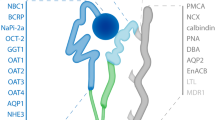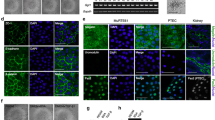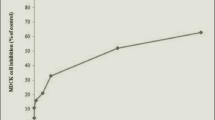Abstract
Background
Madin Darby Canine Kidney (MDCK) cells form polarized epithelium in vitro and are routinely used in research fields ranging from protein trafficking to influenza. However, the canine origin of these cells also means that compared to man or mouse, genomic resources are more limited and performance of commercially available antibodies often untested. The synthesis of pro-inflammatory prostaglandins in the kidney is mediated by the constitutively expressed cyclooxygenase 1 and the inducible cyclooxygenase 2 (COX-1 and COX-2, respectively). There are conflicting reports on the expression of COX-1 and COX-2 in MDCK cells and this lingering uncertainty about such important pharmacological targets may affect the interpretation of results obtained from this cell line.
Results
In order to definitively settle the issue of cyclooxygenase expression in MDCK cells, we designed PCR primers based on dog genomic sequences to probe COX-1 and COX-2 mRNA expression in MDCK cells and dog kidney. We report that while COX-1 and COX-2 genes are both expressed in dog kidney, COX-1 expression is undetectable in MDCK cells.
Conclusions
By improving the characterization of cyclooxygenase expression in MDCK cells, this study will contribute to a better understanding of the properties of this cell line and lead to improved experimental designs and data interpretations.
Similar content being viewed by others
Background
Cyclooxygenases are important pharmacological targets, as they are involved in the synthesis of pro-inflammatory prostaglandins [1]. In addition to the constitutively expressed cyclooxygenase 1 (COX-1), the inducible cyclooxygenase 2 (COX-2) is also robustly expressed in the kidney where it plays a role in cellular adaptation to osmotic stress [2,3].
Madin Darby Canine Kidney (MDCK) cells are easy to grow and can form polarized epithelium in vitro. These cells have been used notably in investigations on membrane permeability and tight junctions, protein trafficking, influenza viral infection [4] and phorbol ester-induced inflammatory processes [5]. In the decade or so between identification of the inducible COX-2 gene [6] and sequencing of dog cyclooxygenases [7-10], studies on their expression in MDCK cells assessed COX-1 and COX-2 protein levels by Western blot [2,11-14] and mRNA levels by Northern blot or RT-PCR [11,13,15,16], see Table 1. These studies which were based on antibodies raised against cyclooxygenases from other organisms or on orthologous nucleotide sequences from different species reached conflicting conclusions.
In order to definitively settle the issue of COX-1 and COX-2 expression in MDCK cells, we designed PCR primers based on published dog genomic and mRNA sequences retrieved from ENSEMBL (www.ensembl.org) and NCBI (www.ncbi.nlm.nih.gov) databases for the Prostaglandin G/H synthase 1 and 2 genes (PTGS1 and PTGS2) coding for the COX-1 and COX-2 proteins, respectively. These primers were then used for PCR amplification of mRNA and genomic DNA from MDCK cells and dog kidney.
Results
The expression of COX-1 (PTGS1), COX-2 (PTGS2) and HPRT1 (hypoxanthine phosphoribosyltransferase 1) genes in MDCK cells and dog kidney were assessed under similar experimental conditions. As expected, primers for the housekeeping gene HPRT1 and COX-2 amplified their target sequences from both dog kidney and MDCK cells (Figure 1B). However, while the three primer sets for the COX-1 gene successfully amplified their target sequences from dog kidney mRNA, they failed to amplify mRNA from MDCK cells (Figure 1B). Further PCR investigation using Cox1_E4-5 primers (Table 2) to probe genomic DNAs amplified a 380 bp fragment (including 212 bp of COX-1 intronic sequences) from both dog kidney and MDCK cells (Figure 1B). Hence, although COX-1 mRNA is not detected in MDCK cells, COX-1 coding sequences are present in MDCK genome and the exact reason behind this lack of expression remains to be determined.
Expression of cyclooxygenases in MDCK cells and dog kidney. A) Schematic representation of the exonic structure of the PTGS1 transcript (coding for the COX-1 protein) in dog, mouse, rat and human. Exon structure and alignment were based on NCBI RefSeq NM_001003023, NM_08969, NM_017043 and NM_001271162, accessed on February 6, 2015. Exons are numbered and their lengths indicated along with the locations of the PCR primers used in this study. Exons are not all shown to scale. B) Representative gel showing the expression of COX-1 (PTGS1), COX-2 (PTGS2) and HPRT1 in MDCK cells (M) and dog kidney (K). Three regions of the PTGS1 gene, namely Exon 10-11 (E10-11), E8-9 and E4-5 were targeted for PCR amplification. The Cox1_E4-5 primers were also used to amplify genomic DNA from MDCK cells and dog kidney, generating a larger amplicon (380 bp) due to the inclusion of a 212 bp intron. A 50-bp DNA ladder (L) is shown on the left.
Discussion
Several research groups assessed COX-1 and COX-2 protein levels in MDCK cells by Western blot using antibodies raised against protein epitopes from different mammalian species, often leading to conflicting results [2,11-14,17-20], see Table 1. Although the commercial suppliers of the antibodies were generally mentioned, this information was not always sufficient to identify the specific antibody used. This ambiguity on antibody identities, along with the sometimes incomplete description of the MDCK strain used [4,21], hampered comparison between these studies.
Prior to the availability of dog cyclooxygenase gene sequences, detection of COX-1 and COX-2 mRNA expression in MDCK cells relied on Northern blot using orthologous human or mouse sequences as probes. These investigations also reached differing conclusions [11,15,16] which may be explained by non-specific cross-species hybridisation of the probes. Efforts to assess COX-1 gene expression in MDCK cells by RT-PCR proved unsuccessful [11,13]. Although aberrant cyclooxygenase expression in MDCK cells was suggested [16], incomplete knowledge of the dog genome at that time prevented a definitive conclusion.
In this report, our attempts to amplify COX-1 mRNA from MDCK cells using three different sets of PCR primers designed from dog genomic sequences and covering different regions of the COX-1 gene (Figure 1A) also failed (Figure 1B). The same primer sets were successfully used to amplify their respective targets from dog kidney mRNA, as confirmed by sequencing of the amplicons generated. In light of a report on COX-1 protein induction in MDCK cells [18], we also assessed COX-1 expression in MDCK cells exposed to 12-O-tetradecanoylphorbol-13-acetate (TPA) as described in [22], failing again to detect any expression (data not shown). It is theoretically possible that the relatively long half-life of COX-1 protein [23] results in the presence of a residual level of this enzyme despite undetectable gene expression. However, our failure to detect COX-1 mRNA after 35 PCR amplification cycles suggests at best an infinitesimal expression and questions the biological plausibility of a significant role for this enzyme in the synthesis of pro-inflammatory prostaglandin mediators by MDCK cells.
Despite the use of multiple primer sets (to prevent false negative results due to faulty primers or alternative splicing), the inclusion of a positive control for COX-1 gene expression (dog kidney mRNA), PCR amplifications conducted for up to 35 cycles (to ensure detection of minute expression), confirmation of amplification specificity (by sequencing of the amplicons), and additional verifications of its inducibility (following induction of prostaglandin synthesis in TPA-treated cells), we were consistently unable to detect COX-1 gene expression in MDCK cells. Hence, we reach the same conclusion as older RT-PCR investigations predating sequencing of dog COX-1 and COX-2 genes [11,13]. Our survey of curated dog microarray datasets at NCBI’s Gene Expression Omnibus database (www.ncbi.nlm.nih.gov/geo, accessed on February 13, 2014) also revealed that while COX-1 and COX-2 expression is detected in several dog tissues (for example, see dataset GDS4164), COX-1 is flagged as absent in MDCK cells (dataset GDS3267).
Conclusions
We conclude that in absence of detectable COX-1 gene expression, prostaglandin synthesis and associated inflammatory processes in MDCK cells are mediated by the inducible COX-2 gene. However, COX-1 gene expression in MDCK cells is sometimes assumed and the specific COX-1 inhibitor SC-560 used [3,13,18-20,24]. Our results clearly suggest that effects of this inhibitor in MDCK cells are most likely independent of COX-1 inhibition [25]. This improved characterization of cyclooxygenase expression in MDCK cells provides new insights into the biology of this cell line and will contribute to better experimental design and enhanced interpretation of the results obtained.
Methods
Reagents and cell culture
The MDCK (NBL-2) cell line was purchased from American Type Culture Collection (ATCC, Manassas, VA, USA) in 2002, grown for a few passages and then cryopreserved in liquid nitrogen. MDCK cell aliquots used in this study were sub-cultured for a maximum of 15 passages. Cell culture media and fetal bovine serum were also purchased from ATCC. MDCK cells were grown in Eagle Minimum Essential Medium with Earle’s Balanced Salt Solution, 10% fetal bovine serum and 1% penicillin-streptomycin (Life Technologies, Burlington, ON, Canada) in a humidified incubator at 37°C and 5% CO2. MDCK cells seeded at 70,000 cells/cm2 were allowed to grow for two days before nucleic acid isolation.
Total RNA and genomic DNA isolation
Total RNA from MDCK cells was isolated and purified using the RNeasy kit (Qiagen, Toronto, ON, Canada). Dog kidney total RNA was purchased from Zyagen (San Diego, CA, USA), and further purified by RNeasy kit after DNase treatment to avoid genomic DNA contamination. RNA was quantified using a Nanodrop 1000 spectrometer (Thermo Scientific, Waltham, MA, USA) and its integrity assessed using a 2100 Bioanalyzer (Agilent Technologies, Mississauga, ON, Canada). Dog genomic DNA was obtained from Zyagen. MDCK genomic DNA was purified using Flexi Gene DNA kit (Qiagen).
Primer design and PCR amplification
Approaches for primer design and PCR amplification were previously described [26]. Briefly, primers were designed from dog PTGS1 (COX-1), PTGS2 (COX-2) and hypoxanthine phosphoribosyltransferase 1 (HPRT1) nucleotide sequences retrieved from the NCBI Refseq database (Table 2). Two micrograms of total RNA were used for first strand cDNA synthesis, using Superscript III™ reverse transcriptase (Life Technologies) and one-fifth of the cDNA reaction or 100 ng genomic DNA was used for gene expression analyses. PCR reactions were carried out for 35 amplification cycles (30 s denaturation at 94°C, 30 s annealing at 60°C and 60 s extension at 72°C). PTGS1 and PTGS2 amplification products were assessed on agarose gels and sequenced to confirm their identities. Gene expression assessment was performed on at least 4 different control RNA samples from another investigation using MDCK cells [22], while assessment of MDCK genomic sequence was performed on 5 different genomic DNA samples.
Abbreviations
- COX-1 :
-
Cyclooxygenase 1
- COX-2 :
-
Cyclooxygenase 2
- EGF:
-
Epidermal Growth Factor
- HPRT1 :
-
Hypoxanthine phosphoribosyltransferase 1
- MDCK:
-
Madin Darby Canine Kidney
- PTGS1 :
-
Prostaglandin G/H synthase 1
- PTGS2 :
-
Prostaglandin G/H synthase 2
- RT-PCR:
-
Reverse transcription-polymerase chain reaction
- TPA:
-
12-O-tetradecanoylphorbol-13-acetate
References
Langenbach R, Loftin CD, Lee C, Tiano H. Cyclooxygenase-deficient mice. A summary of their characteristics and susceptibilities to inflammation and carcinogenesis. Ann N Y Acad Sci. 1999;889:52–61.
Yang T, Schnermann JB, Briggs JP. Regulation of cyclooxygenase-2 expression in renal medulla by tonicity in vivo and in vitro. Am J Physiol. 1999;277:F1–9.
Neuhofer W, Steinert D, Fraek ML, Beck FX. Prostaglandin E2 stimulates expression of osmoprotective genes in MDCK cells and promotes survival under hypertonic conditions. J Physiol. 2007;583:287–97.
Dukes JD, Whitley P, Chalmers AD. The MDCK variety pack: choosing the right strain. BMC Cell Biol. 2011;12:43.
Daniel LW, Sciorra VA, Ghosh S. Phospholipase D, tumor promoters, proliferation and prostaglandins. Biochim Biophys Acta. 1999;1439:265–76.
Xie WL, Chipman JG, Robertson DL, Erikson RL, Simmons DL. Expression of a mitogen-responsive gene encoding prostaglandin synthase is regulated by mRNA splicing. Proc Natl Acad Sci U S A. 1991;88:2692–6.
Boutemmine D, Bouchard N, Boerboom D, Jones HE, Goff AK, Dore M, et al. Molecular characterization of canine prostaglandin G/H synthase-2 and regulation in prostatic adenocarcinoma cells in vitro. Endocrinology. 2002;143:1134–43.
Chandrasekharan NV, Dai H, Roos KL, Evanson NK, Tomsik J, Elton TS, et al. COX-3, a cyclooxygenase-1 variant inhibited by acetaminophen and other analgesic/antipyretic drugs: cloning, structure, and expression. Proc Natl Acad Sci U S A. 2002;99:13926–31.
Lindblad-Toh K, Wade CM, Mikkelsen TS, Karlsson EK, Jaffe DB, Kamal M, et al. Genome sequence, comparative analysis and haplotype structure of the domestic dog. Nature. 2005;438:803–19.
Kirkness EF, Bafna V, Halpern AL, Levy S, Remington K, Rusch DB, et al. The dog genome: survey sequencing and comparative analysis. Science. 2003;301:1898–903.
Schaefers HJ, Haselmann J, Goppelt-Struebe M. Regulation of prostaglandin synthesis in Madin Darby canine kidney cells: role of prostaglandin G/H synthase and secreted phospholipase A2. Biochim Biophys Acta. 1996;1300:197–202.
Sciorra VA, Daniel LW. Phospholipase D-derived products in the regulation of 12-O-tetradecanoylphorbol-13-acetate-stimulated prostaglandin synthesis in madin-darby canine kidney cells. J Biol Chem. 1996;271:14226–32.
Ostrom RS, Gregorian C, Drenan RM, Gabot K, Rana BK, Insel PA. Key role for constitutive cyclooxygenase-2 of MDCK cells in basal signaling and response to released ATP. Am J Physiol Cell Physiol. 2001;281:C524–31.
Benitah SA, Valeron PF, Lacal JC. ROCK and nuclear factor-kappaB-dependent activation of cyclooxygenase-2 by Rho GTPases: effects on tumor growth and therapeutic consequences. Mol Biol Cell. 2003;14:3041–54.
Cowley Jr BD, Muessel MJ, Douglass D, Wilkins W. In vivo and in vitro osmotic regulation of HSP-70 and prostaglandin synthase gene expression in kidney cells. Am J Physiol. 1995;269:F854–62.
Kay-Mugford PA, Benn SJ, LaMarre J, Conlon PD. Cyclooxygenase expression in canine platelets and Madin-Darby canine kidney cells. Am J Vet Res. 2000;61:1512–6.
Knottenbelt C, Chambers G, Gault E, Argyle DJ. The in vitro effects of piroxicam and meloxicam on canine cell lines. J Small Anim Pract. 2006;47:14–20.
Reyes-Martin P, Alique M, Parra T, Hornedo JP, Lucio-Cazana J. Cyclooxygenase-independent inhibition of H2O2-induced cell death by S-ketoprofen in renal cells. Pharmacol Res. 2007;55:295–302.
Flores-Benitez D, Rincon-Heredia R, Razgado LF, Larre I, Cereijido M, Contreras RG. Control of tight junctional sealing: roles of epidermal growth factor and prostaglandin E2. Am J Physiol Cell Physiol. 2009;297:C611–20.
Steinert D, Kuper C, Bartels H, Beck FX, Neuhofer W. PGE2 potentiates tonicity-induced COX-2 expression in renal medullary cells in a positive feedback loop involving EP2-cAMP-PKA signaling. Am J Physiol Cell Physiol. 2009;296:C75–87.
Cassio D. Long term culture of MDCK strains alters chromosome content. BMC Res Notes. 2013;6:162.
Pelletier G, Padhi BK, Hawari J, Sunahara GI, Poon R Development of a sensitive in vitro assay to quantify the biological activity of pro-inflammatory phorbol esters in Jatropha oil. In Vitro Cell Dev Biol Anim 2015. doi:10.1007/s11626-014-9861-z
Mbonye UR, Wada M, Rieke CJ, Tang HY, Dewitt DL, Smith WL. The 19-amino acid cassette of cyclooxygenase-2 mediates entry of the protein into the endoplasmic reticulum-associated degradation system. J Biol Chem. 2006;281:35770–8.
Loerke D, le Duc Q, Blonk I, Kerstens A, Spanjaard E, Machacek M, et al. Quantitative imaging of epithelial cell scattering identifies specific inhibitors of cell motility and cell-cell dissociation. Sci Signal. 2012;5:5.
Brenneis C, Maier TJ, Schmidt R, Hofacker A, Zulauf L, Jakobsson PJ, et al. Inhibition of prostaglandin E2 synthesis by SC-560 is independent of cyclooxygenase 1 inhibition. FASEB J. 2006;20:1352–60.
Padhi BK, Pelletier G. Perturbation of myelin basic protein (Mbp) splice variant expression in developing rat cerebellum following perinatal exposure to methylmercury. Toxicol Lett. 2012;213:374–80.
Acknowledgements
The authors wish to thank Drs. Phil Shwed and Karthikeyan Subramanian for critical review of this manuscript. This work was supported by the Program of Energy Research and Development (PERD project C24.001) from Natural Resources Canada (NRcan).
Author information
Authors and Affiliations
Corresponding author
Additional information
Competing interests
The authors declare that they have no competing interests.
Authors’ contributions
GP prepared the manuscript, figure and table. BKP designed primers, performed experimental work and revised the manuscript. Both authors read and approved the final manuscript.
Rights and permissions
This article is published under an open access license. Please check the 'Copyright Information' section either on this page or in the PDF for details of this license and what re-use is permitted. If your intended use exceeds what is permitted by the license or if you are unable to locate the licence and re-use information, please contact the Rights and Permissions team.
About this article
Cite this article
Pelletier, G., Padhi, B.K. Cyclooxygenase 1 mRNA expression is undetectable in Madin Darby Canine Kidney cells. BMC Res Notes 8, 93 (2015). https://doi.org/10.1186/s13104-015-1049-4
Received:
Accepted:
Published:
DOI: https://doi.org/10.1186/s13104-015-1049-4





